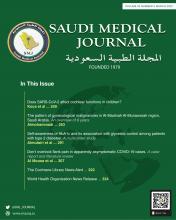To the Editor
We read with interest the study by Obeid et al1 on “The effect of wet-cupping therapy (hijama) in modulating autoimmune activity in Hashimoto’s thyroiditis”. The authors did not report any side effects in the cupping group. Our second comment is the use of erythrocyte sedimentation rate (ESR) rather than C-reactive protein (CRP). C-reactive protein measures CRP, an acute phase reactant, in contrast to the ESR, which indirectly measures the acute phase response by the effect of fibrinogen on the descent of red cells in a column of blood. In addition, ESR is affected by other components of the blood such immunoglobulins and changes in the shape, size, and number of red blood cells.2
We recently reviewed the evidence for its therapeutic use of cupping in rheumatic diseases and concluded that more robust, carefully controlled and better designed studies were needed.3 Initially, cupping in various forms, was mainly practiced for the alleviation of pain by various cultures, ancient Egyptians, Arabs, Chinese, Greek, and more recently Europeans and Americans. Currently, cupping is being increasingly used for treating autoimmune and inflammatory diseases, either as monotherapy or in combination with standard drug therapy with variable outcomes. There are several forms of cupping: dry, wet, moving, and fire. Cupping can cause serious side effects especially blood born infections including hepatitis C.4 We have reported a patient who developed septic arthritis of the knee.5
We welcome the pilot study by Obeid et al.1 Larger, controlled, prospective, preferably multi-centre studies are needed to study the possible therapeutic benefit of the various forms of cupping in different medical conditions. Preliminary reports suggest cupping works better in combination with standard pharmacotherapy.
Reply from the Author
No reply was received from the Author.
- Copyright: © Saudi Medical Journal
This is an Open Access journal and articles published are distributed under the terms of the Creative Commons Attribution-NonCommercial License (CC BY-NC). Readers may copy, distribute, and display the work for non-commercial purposes with the proper citation of the original work.






